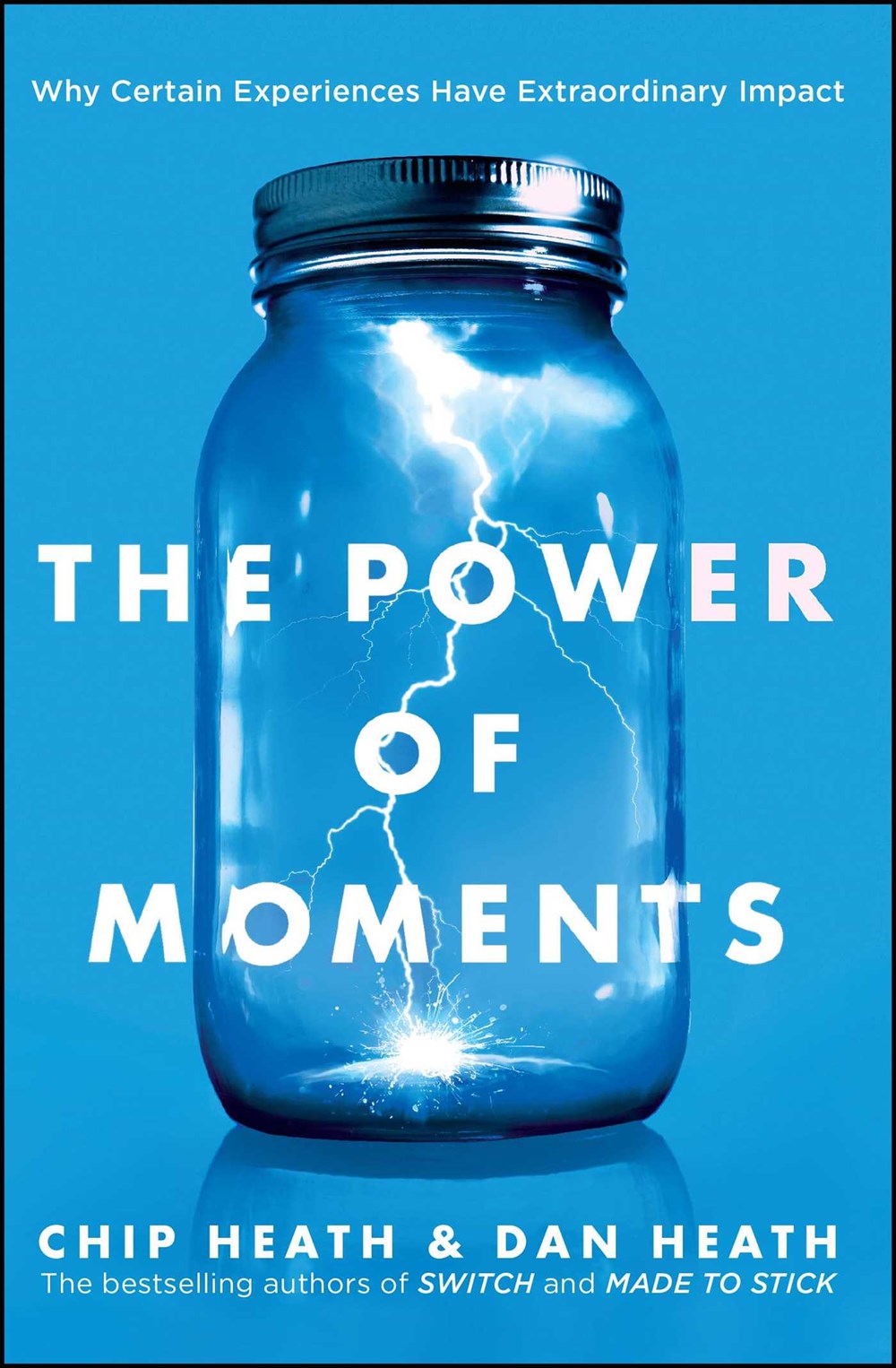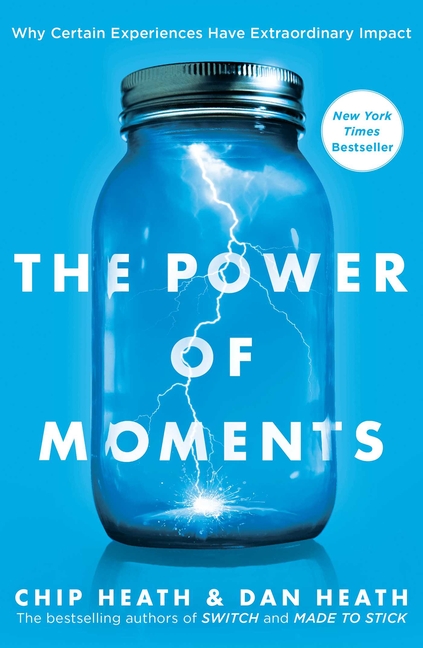The Power of Moments: Why Certain Experiences Have Extraordinary Impact
October 05, 2017
Chip and Dan Heath show us how to make the most of the moments that are presented to us, and how to manufacture more impactful moments for ourselves and others.

The Power of Moments: Why Certain Experiences Have Extraordinary Impact by Chip Heath and Dan Heath, Simon & Schuster, 320 pages, Hardcover, October 2017, ISBN 9781501147760
The Heath brothers are among the best storytellers writing business books today. And they have used that rare ability to tackle the most fundamental questions in life and work: how to make our ideas alluring and effectual in Made to Stick, how to make better choices in Decisive, and how to make lasting change in Switch. In their new book, out this week, the brothers turn their attention to something even more central to our lives—the moments they are made of, how to make the most of them, and how to make more of them:
Defining moments shape our lives, but we don’t have to wait for them to happen. We can be the authors of them. What if a teacher could design a lesson that students were still reflecting on years later? What if a manager knew exactly how to turn an employee’s moment of failure into a moment of growth? What if you had a better sense of how to create lasting memories for your kids?
You can. In their research, they have found there are four elements present in defining moments: elevation (they rise above the everyday), insight (they change our understanding of the world), pride (they are when we are at our best), and connection (they are social). They devote a section of the book to each.
They tell the story John Dietz, who spent two years at GE designing a new MRI machine, only to be emotionally crushed the first time he saw it in use. He was jubilant when it was installed, until he saw the first patient walk up to use it—a little girl who was visibly frightened by what she saw. He had been focused on building a technically better machine for two years, and realized in that moment of insight that he had neglected to design a better experience. So he and his team went back to work, and designed MRI suites that were delightful experiences for children—a Jungle Adventure room with a table designed to look like a canoe that was floating through a jungle, in which children were instructed to hold still (critical to getting a good MRI) so as not to rock the boat. There is Pirate Island, in which the machine is painted like a pirate ship with a plank the children must walk to enter it. And, in San Francisco, Cable Car Adventure room, designed to look like the city’s famous cable cars, which also helped hospital staff give a fanciful explanation to children for why the machines are so noisy. The success of these machines was immediate. The number of children needed to be sedated to stay still in the machines dropped from 80% to 27%. The kids most anxious moment—entering the machine—was turned into an adventure. By lessening the amount of time it took to get kids onto the table, it also meant the hospital could accomplish more MRIs each day, increasing efficiency as well as the kids’ experience.
But Dietz knew the new machines were really successful when, as he was talking with the mother of a child who had just received an MRI, the little girl began tugging at her shirt to get her attention:
The little girl asked, “Can we come back tomorrow?”
Dietz began to weep. He had transformed terror into delight.
Sonia Rhodes had a similar epiphany when she witnessed the care her father received in a hospital managed by Sharp HealthCare, an organization she just happened to have an executive role in. It was an experience that made her realize they were focused so much on improving medical treatment that they had neglected the experience of the patients. They were being treated more as problems that needed to be solved than people that needed to be served. She eventually got the attention of Sharp’s CEO, and they set out to transform the service experience in their hospital—first and foremost by making it “the best place for employees to work” and “the best place for physicians to practice.” The first thing they did to do that was gather all 12,000 employees off-site, over the course of three days, for an All-Staff Assembly, creating a moment of connection that united them behind a new mission to be “the best place for patients to receive care” and “the best health care system in the universe.”
The cafe chain Pret A Manger allows employees to give away a certain amount of free items each week, at their own discretion, allowing its café staff to regularly delight customers by breaking the expected script of the transaction, and creating a moment that rises above the everyday. Southwest Airlines does the same by encouraging their flight attendants to inject some humor into their safety announcements. Of course, you don’t want to break the script or surprise people in negative ways. You should maintain a certain level of professionalism, and maintain a standard of service. But you must also give your employees the freedom to surpass it.
The Heaths explain why, when creating moments of insight, you should focus on the problem being addressed, not the solution to it—why, instead of delivering a sales pitch for the answer you have in mind, you need your audience to “trip over the truth” of the problem. And, to spark personal insight, the authors encourage us to stretch, to take a risk and try something new, and to encourage—even expect—others to do so if we’re trying to develop them as employees and people. They also clarify why recognizing employees is so important, and why an Employee of the Month program won’t work to do so.
One of the inspiring aspects of their storytelling is their subjects. That should be obvious, I suppose, but the Heaths' subjects are not the usual suspects. There are some people profiled in the book you may recognize, but the pages are mostly populated with what most would call “ordinary” or “everyday” people. They are high school teachers, vice presidents of companies you’ve never heard of, a woman who decided starting her own bakery wasn’t what she wanted to do, after all. There’s even an ever so brief Simpsons quote in a footnote, bringing that fictional everyman into the narrative.
And it teaches us to pull out what is extraordinary in us, and in the moments we inhabit. They tell of the courage displayed in the civil rights sit-ins at lunch counters in Nashville, and how they practiced that courage under the direction of Methodist minister, James Lawson, who had travelled to India to study the techniques of Gandhi’s nonviolent resistance. It is something that is mirrored in the curriculum designed by Mary Gentile, author of Giving Voice to Values, which advocates that leaders practice responses to ethical issues that could arise before they occur. The idea is that most people know the right thing to do, it simply takes courage to do it, and courage takes practice.
You’ll hear the story of two teachers in California who started an annual mock trial of human nature that is a hallmark of students’ time in school—eclipsing even events like prom and homecoming in popularity. The Heaths compare it to sports, making the case that no one would go out for sports teams if all you ever did was practice. The trial is the student’s academic version of game day. You’ll also learn how to use game-design to manufacture more milestones on the way to an ultimate goal, and how instituting home visits from teachers to ask about parents' dreams for their kids turned a Washington D.C. school around.
Life is made up of moments and what we do with them. We can make more of those moments, large and small, memorable—more impactful for ourselves and others. We can provide better service, be better colleagues and bosses, better spouses and parent, and can better our selves, simply by making more meaningful moments. The Heath brothers show us how.


